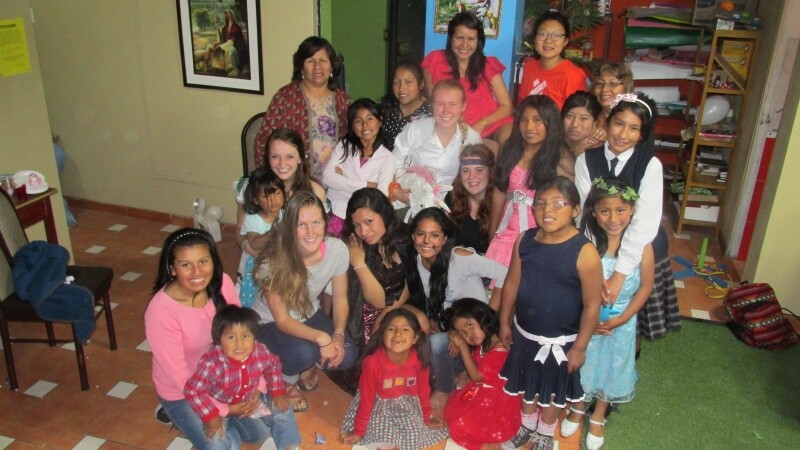
by Keely Kriho
On my first morning in Arequipa, Peru, I awoke with a start to a little girl’s shrill voice speaking directly into my ear. “Como te llamas?” As my eyes adjusted and my vision cleared, Alejandra’s smiling face appeared a few inches from mine. After one week, I had become used to this wake-up routine.

“Tu sabes! [You know!]” I responded, since this was Alejandra’s favorite question, and I had definitely given her an answer before. But either she had forgotten, or she liked to mess with me (I’d say probability was 20/80), and she continued to smile, waiting for a legitimate reply to her question.
“Me llamo Keely!” I exclaimed, sitting up in bed and looking over at the clock: 5:15 AM.
Alejandra clapped and laughed, repeating, “Te llamas Kee-lee, te llamas Kee-lee.” This boisterousness piqued the attention of Jeffrey and Anna Paula, two other toddlers around 3 or 4 years old, who quickly joined Alejandra in bidding Caleigh, my roommate, and I good morning. I yawned and hopped out of bed, extremely tired due to the early hour but excited to start another day playing with toddlers at the Albuergue, a home for girls aged two to seventeen whose parents are unable to care for them sufficiently, and who now, through donations to the organization, receive an education, three meals a day, and loving support.

It hurts to imagine these girls living in the conditions from which they came—they were so kind, smart, and welcoming.
The work that we were doing in Arequipa was helping to build an extra bedroom that would give the girls more space, since conditions had gotten cramped due to an increase in the number of girls living there. The work we were doing was good, necessary work, and, like any construction project, it was slow at the start, and we spent a lot of our first few days having fun playing with the little kids.

For me, a difficult-to-place feeling permeated the work. I knew that we were all trying to do something good by volunteering our time for this project (and I truly believe this is everyone’s intention with service experiences or trips, including and especially those planning the programs), but—reminiscent of our service projects in Pucara—our time doing this project was so short, and our experience so limited, that I was unsure if we were really helping in the most beneficial way.
During this gap year, I wanted to be involved in service, to volunteer my time where it was most needed, and to make a difference, and one of the reasons I was hesitant to do a “program” was because I feel that to contribute the most to the community you hope to work in, it is necessary to spend an extensive period of time really getting to know the place, the people, and the work you will be doing.
I realize that my views were idealistic and perhaps naïve, but even so, it was difficult to realize that my fears about doing a structured program—that the lack of time in each place would mean contributing to the “voluntourism” culture and not actually helping to the full extent I felt was possible—had, perhaps, come true. And I knew from the beginning that I was not setting out to “change the world,” that I’d merely be helping with what people needed help with, in whatever way I could; but I almost felt that, being an outsider coming to “volunteer” for one short week, we were treated as superior because we provided the money for the project and were made to feel like we were really changing the lives of the people much more than we actually were.
Spending so little time in a place doesn’t allow for volunteers to reach their full potential in terms of work, because you can’t get to know a community well enough to help out in the most beneficial ways in just one week. Even most well-meaning programs, staffed with absolutely outstanding program coordinators and leaders (like Carpe Diem!), are unable to prevent this from happening, simply because the time doesn’t allow for it.
And I want to be clear: it is not as though I feel that the work we did at the Albergue was not overall positive, because it was, or that I am not grateful for the experience, because I absolutely am! The work we did provided a service that the organization had specifically asked for, that would benefit the girls, and by working in such close proximity to them, we got to know them and to see the amazing people they are.
But our lack of qualification, and the lack of time spent really getting to know the community, made my feelings about it ambiguous, and, more than anything, it made me realize how vigilant I need to be as a volunteer in choosing projects that will truly provide services that are needed, that I am qualified to do, and that allow a volunteer to really get to know the place and culture.
I am excited for next semester, when I get to spend four months in one place, to see if my views on volunteering for longer periods of time remain the same. And no doubt I will blog about that!
I went on this service trip thinking it would be very much focused on the service aspect, but I have gained so much in other areas not directly related to the projects, and I’ve realized that these parts are equally as important as volunteering. I was impacted me the most by cooking with Rosa, who was the “mother” of the home; getting to help Nielda with her English homework (as best I could…); celebrating Ruth’s birthday with a ton of candy and dancing; planning and dressing up for the Harvest Festival (Halloween) party with the girls; getting woken up at 5 in the morning by the toddlers and playing with them on their swing for the majority of the day: These were the things that made the experience meaningful to me, more than the actual physical work I was doing. Developing the relationships with the girls—that’s truly where the growth, happiness, and satisfaction came from, and I’m so grateful for that. Speaking of which…
Three things I’m grateful for from these two weeks in Arequipa:
- My newfound fourteen sisters, of course!
- The five other Carpe Diem girls who travelled via combi with me at least four times a day, and who ate meals with me (and who helped me get through Chicha Morada, aka The Purple, a traditional dish that tastes like a warmish, slightly watery Jello).
- Getting to spend quality time with Ryan and Cheridyn (my group leaders) when we went with their homestay family to visit the miradores (scenic overlooks) and took in spectacular views of Arequipa. Not to mention the bullfight we watched along the way, and the delicious pollo a la brasa we ate afterwards.

